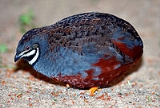
Coturnix
Encyclopedia
Coturnix is a genus
of Old World quail
in Phasianidae
.
A fossil
species from the Late Oligocene
- Late Miocene
of SW and Central Europe was described as Coturnix gallica. Another, C. donnezani, was widespread in Early Pliocene to Early Pleistocene
Europe.
Genus
In biology, a genus is a low-level taxonomic rank used in the biological classification of living and fossil organisms, which is an example of definition by genus and differentia...
of Old World quail
Quail
Quail is a collective name for several genera of mid-sized birds generally considered in the order Galliformes. Old World quail are found in the family Phasianidae, while New World quail are found in the family Odontophoridae...
in Phasianidae
Phasianidae
The Phasianidae is a family of birds which consists of the pheasants and partridges, including the junglefowl , Old World Quail, francolins, monals and peafowl. The family is a large one, and is occasionally broken up into two subfamilies, the Phasianinae, and the Perdicinae...
.
Species list
- Blue QuailBlue QuailThe Blue Quail or African Blue Quail, is a species of bird in the Phasianidae family.-Geographic Range:The species ranges from Sierra Leone to Ethiopia, and south to Zambia, and eastward to Kenya, and is migratory...
, Coturnix adansonii - King Quail, Coturnix chinensis
- Rain QuailRain QuailThe Rain Quail or Black-breasted Quail is a species of quail found in South Asia.-Distribution:Grassland, cropped fields, and scrubs in the Indus valley of central India, Pakistan, the Gangetic plains, and parts of peninsular continental India. Mostly seen in winter further south.-Description:The...
, Coturnix coromandelica - Harlequin QuailHarlequin QuailThe Harlequin Quail is a species of bird in the Phasianidae family.It is found in Africa.-References:* BirdLife International 2004. . Downloaded on 10 July 2007....
, Coturnix delegorguei - Common QuailCommon QuailThe Common Quail, Coturnix coturnix, is a small bird in the pheasant family Phasianidae. It is widespread and is found in parts of Europe, .- Description :It is a small rotund bird, essentially streaked brown with...
, Coturnix coturnix - †Canary Islands QuailCanary Islands QuailThe Canary Islands Quail once occurred on the islands of El Hierro, La Palma, Tenerife and Fuerteventura . It might also have inhabited Gran Canaria and Lanzarote, but there are no remains found on these islands....
, Coturnix gomerae (fossil) - Japanese QuailJapanese QuailThe Japanese Quail, also known as Coturnix Quail, Coturnix japonica, is a species of Old World Quail found in East Asia. They are a migratory species, breeding in Manchuria, southeastern Siberia, northern Japan, and the Korean Peninsula, and wintering in the south of Japan and southern China. They...
, Coturnix japonica - †New Zealand QuailNew Zealand QuailThe New Zealand Quail , or koreke , has been extinct since 1875. The male and female were similar, except the female was lighter. The first scientist to describe it was Sir Joseph Banks when he visited New Zealand on James Cook's first voyage...
, Coturnix novaezelandiae (extinct) - Stubble QuailStubble QuailThe Stubble Quail, Coturnix pectoralis is an Australian quail of the family Phasianidae. It has sometimes been considered conspecific with the extinct New Zealand Quail. In this case, the latter species' name would have priority and the Stubble Quail would become Coturnix novaezelandiae pectoralis...
, Coturnix pectoralis - Brown QuailBrown QuailThe Brown Quail , also known as Swamp Quail, is an Australasian true quail of the family Phasianidae.The Brown Quail is distributed in agricultural areas, wet grasslands, shrublands and freshwater wetlands across much of New Guinea and the Lesser Sunda Islands as well as in northern, eastern,...
, Coturnix ypsilophora
A fossil
Fossil
Fossils are the preserved remains or traces of animals , plants, and other organisms from the remote past...
species from the Late Oligocene
Oligocene
The Oligocene is a geologic epoch of the Paleogene Period and extends from about 34 million to 23 million years before the present . As with other older geologic periods, the rock beds that define the period are well identified but the exact dates of the start and end of the period are slightly...
- Late Miocene
Miocene
The Miocene is a geological epoch of the Neogene Period and extends from about . The Miocene was named by Sir Charles Lyell. Its name comes from the Greek words and and means "less recent" because it has 18% fewer modern sea invertebrates than the Pliocene. The Miocene follows the Oligocene...
of SW and Central Europe was described as Coturnix gallica. Another, C. donnezani, was widespread in Early Pliocene to Early Pleistocene
Early Pleistocene
Calabrian is a subdivision of the Pleistocene Epoch of the Geologic time scale. ~1.8 Ma.—781,000 years ago ± 5,000 years, a period of ~.The end of the stage is defined by the last magnetic pole reversal and plunge in to an ice age and global drying possibly colder and drier than the late Miocene ...
Europe.

